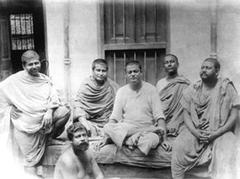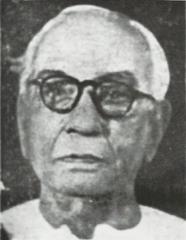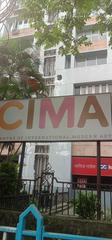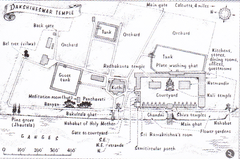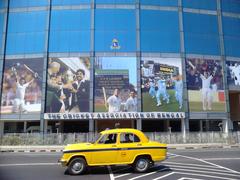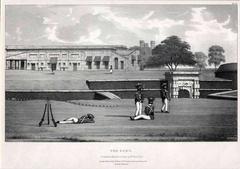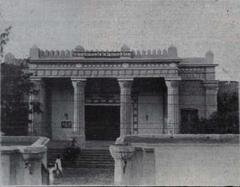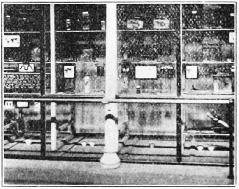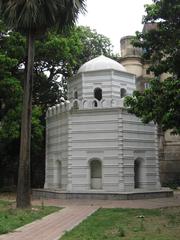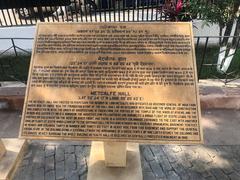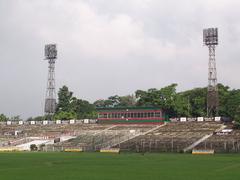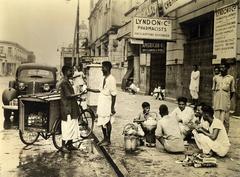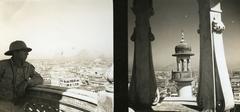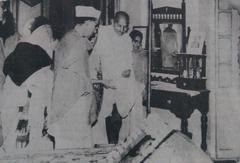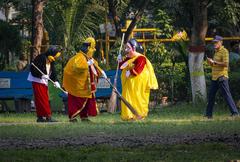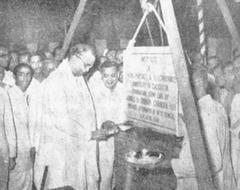Joka Metro Station Kolkata: Visiting Hours, Tickets, and Travel Guide
Date: 15/06/2025
Introduction to Joka Metro Station Kolkata
Kolkata, a city celebrated for its cultural vibrancy and historical legacy, has long grappled with complex urban transport challenges. Rapid population growth and sprawling neighborhoods in its southern suburbs, particularly Joka, resulted in limited public transit and lengthy commutes. The expansion of the Kolkata Metro network, initiated in the late 20th century, marked a turning point for urban mobility in the city. Joka Metro Station, as the southern terminal of the Purple Line (Line 3), is now a vital transport hub that significantly improves connectivity between the peripheral areas and Kolkata’s city center. It also stimulates socio-economic growth, enhances accessibility, and supports environmental sustainability.
This detailed guide explores the evolution and significance of Joka Metro Station, providing practical information on operational details such as visiting hours, ticketing systems, station facilities, accessibility, and nearby attractions like the Indian Institute of Management Calcutta (IIM Calcutta). Additionally, it examines the station’s broader impact on urban development, real estate, and sustainable living in Kolkata. Whether you are a daily commuter, a first-time visitor, or an urban development enthusiast, this guide offers essential insights and travel tips to help you make the most of your experience at Joka Metro Station (MetroRailNews, Wikipedia, UPEXCisePortal, Yometro).
Table of Contents
- Early Urban Transport Challenges in Kolkata
- Vision for a Modern Metro: Early Proposals and Delays
- The Birth of Kolkata Metro and Its Expansion
- The Genesis of the Joka Metro Station and Purple Line
- Joka Metro Station: Facilities, Layout, and Accessibility
- Visitor Information: Hours, Tickets, and Travel Tips
- Socio-Economic and Environmental Impact
- Technical and Operational Milestones
- Nearby Attractions
- Frequently Asked Questions (FAQ)
- Useful Links and References
Early Urban Transport Challenges in Kolkata
Kolkata, formerly Calcutta, has always been a major urban nucleus in India. As its population burgeoned during the 19th and 20th centuries, the city’s narrow streets and dense neighborhoods became increasingly congested. Its road and tram networks struggled to support the growing demand, especially in the southern suburbs like Joka, which were often disconnected from efficient public transport systems. This resulted in long and inconvenient commutes for residents and stalled equitable urban growth (MetroRailNews).
Vision for a Modern Metro: Early Proposals and Delays
Efforts to introduce rapid transit in Kolkata date back to the early 20th century. In 1919, the Imperial Legislative Council in Shimla formed a committee, headed by W. E. Crum, to assess the feasibility of a metro line. The proposed 10.4 km route from Bagmari to Benaras Road (Howrah), passing under the Hooghly River, was ultimately shelved due to financial and technical constraints (Wikipedia). Subsequent proposals in the 1920s, including Harley Dalrymple-Hay’s north-south and east-west corridors, also failed to materialize, leaving the city in need of a transformative transport solution (NowOnline).
The Birth of Kolkata Metro and Its Expansion
The concept of a metro system was revived in the late 1960s, leading to the formation of the Metropolitan Transport Project (MTP) in 1969. The MTP’s 1971 master plan envisioned 97.5 km of metro corridors across Kolkata. The city’s first north-south corridor, from Dum Dum to Tollygunge, began construction in 1972, and Kolkata became the first Indian city to operate a metro with the opening of the Esplanade to Bhowanipur (Netaji Bhavan) segment in 1984 (MetroRailNews, Wikipedia). Over the following decades, the network expanded steadily, serving hundreds of thousands of passengers daily. However, the southern fringes, including Joka, remained outside the metro’s reach for years (NowOnline).
The Genesis of the Joka Metro Station and Purple Line
The Joka Metro Station is an essential node on the Purple Line (Line 3), known as the Joka–Esplanade Corridor. Conceived to address the transport needs of southern Kolkata, this project was managed by Rail Vikas Nigam Limited (RVNL). The first operational stretch, from Joka to Taratala (6.5 km), was inaugurated in December 2022, overcoming significant hurdles such as land acquisition, technical challenges, and delays caused by the COVID-19 pandemic (UPEXCisePortal, GKBooks). The project’s initial phase cost approximately ₹1,350 crore.
Joka Metro Station: Facilities, Layout, and Accessibility
Station Layout and Structure
Located in Bratachari Gram, Joka, Kolkata 700104 (Yometro), Joka Metro Station is a modern, elevated structure with three levels:
- Ground Level: Entry/exit points, security checks, and access to escalators, elevators, and stairs.
- Concourse Level: Ticket counters, ATMs, customer service, and amenities.
- Platform Level: Two side platforms serving trains towards Majerhat and future expected extensions (Wikipedia, Magicbricks).
Accessibility and Passenger Comfort
The station is designed for universal accessibility:
- Elevators and escalators ensure barrier-free movement.
- Tactile flooring aids visually impaired travelers.
- Wide gates accommodate wheelchairs and strollers.
- Real-time information is provided through audio-visual announcements and digital displays (Yometro).
Safety and Amenities
- Comprehensive CCTV surveillance and security personnel are present.
- Clean restrooms, drinking water dispensers, seating areas, and lost & found counters are available.
- ATMs and customer service facilities are provided for passenger convenience.
Visitor Information: Hours, Tickets, and Travel Tips
Operating Hours
- First Train: 8:30 AM
- Last Train: 3:10 PM
- Frequency: Every 10–15 minutes during operational hours (Yometro, Magicbricks)
Ticketing and Fares
- Ticket Counters and ATVMs: Available at the concourse level for single-journey tokens and smart card recharge.
- Smart Cards: Rechargeable online or at the station; offer discounted fares (Tusk Travel).
- UPI Payment: Digital ticketing via Unified Payments Interface is being rolled out.
Travel Tips
- Use smart cards for speedy access and cost savings.
- Plan trips outside peak hours for a smoother experience.
- Follow station guidelines: no photography, smoking, or eating inside, and cooperate with security checks (Kolkata Metro Rail).
Connectivity
- By Road: Buses and auto-rickshaws link Joka to other parts of Kolkata.
- By Metro: The Purple Line connects Joka to Taratala, with future extensions planned.
- Parking: No dedicated parking or feeder bus services currently at the station (Yometro), but local transport is readily available.
Socio-Economic and Environmental Impact
Urban Integration and Development
Joka Metro Station has dramatically improved access for the southern suburbs, reducing commute times and enhancing connections to central Kolkata. This is particularly beneficial for students and staff of IIM Calcutta and the growing residential communities in the area (UPEXCisePortal).
Driving Real Estate and Economic Growth
The metro’s arrival has spurred real estate and commercial development in Joka, attracting investment and supporting the region’s modernization (GKBooks).
Environmental Benefits
By reducing reliance on road transport, the metro helps lower congestion and air pollution, advancing Kolkata’s sustainability goals (UPEXCisePortal).
Technical and Operational Milestones
Joka Metro Station and the Purple Line utilize modern, broad-gauge tracks with a 750 V DC third rail. The station features advanced signaling, security systems, and amenities for all passengers (NowOnline, UPEXCisePortal).
Nearby Attractions
- Indian Institute of Management Calcutta (IIMC): A premier business school near Joka, known for its campus and events.
- Diamond Park: Emerging residential and commercial district.
- Sarsuna Lake: Ideal for nature walks and bird watching.
- Central Kolkata: The Purple Line’s planned northern extension will improve access to Esplanade, Eden Gardens, Park Street, and more.
Frequently Asked Questions (FAQ)
Q1: What are Joka Metro Station’s operating hours?
A: First train at 8:30 AM, last at 3:10 PM, with 10–15 minute intervals.
Q2: How do I purchase tickets?
A: Tickets are available at counters, ATVMs, or via the Kolkata Metro app.
Q3: Is the station accessible for differently-abled travelers?
A: Yes, with elevators, ramps, tactile flooring, and dedicated amenities.
Q4: Is there parking at Joka Metro Station?
A: No, but local transport options are available.
Q5: Can I connect to other lines from Joka?
A: Planned extensions will enable interchanges with other metro lines.
Useful Links and References
- Official Kolkata Metro Website
- Joka Metro Station Guide – Yometro
- Kolkata Metro Purple Line Details – Magicbricks
- Kolkata Metro Route Map, Timings & Fare Updates – Tusk Travel
- Joka-Taratala Metro – GKBooks
- Purple Line Project Updates – UPEXCisePortal
- MetroRailNews: Transformational Transport System
- Wikipedia: Kolkata Metro
- NowOnline: Metro Route Map
- Kolkata Metro Rail – Timetables
Visuals and Media
For a virtual tour, visit the official Kolkata Metro website’s virtual tour section.
Summary
Joka Metro Station represents a landmark achievement in Kolkata’s transit evolution—bridging the southern suburbs with the heart of the city. With its inclusive design, modern amenities, and pivotal role in reducing urban congestion, the station stands as a model for sustainable, accessible, and future-ready urban transportation. Visitors and commuters are encouraged to stay updated on operational changes via official sources and to explore the many cultural and educational attractions accessible from Joka Metro Station (GKBooks, NowOnline, Official Kolkata Metro Website).
Experience the transformative impact of Kolkata’s metro expansion—plan your visit to Joka Metro Station and be part of the city’s journey toward greater connectivity and inclusive growth.
